
 |
|
|
#1 |
|
All the news that's fit to excerpt
Name: newsie
Location: who knows?
Join Date: Jun 2008 Motorcycle(s): only digital replicas Posts: Too much.
|
[motorcycle.com] - 2016 Suzuki GSX-S1000 / GSX-S1000F First Ride Review
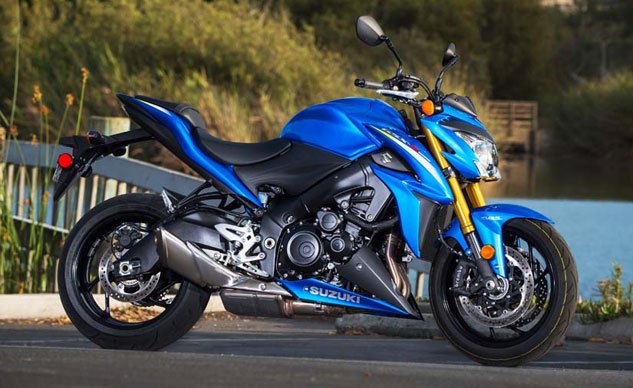 2016 Suzuki GSX-S1000/GSX-S1000F Editor Score: 86.25%Engine 16.0/20Suspension/Handling 12.0/15 Transmission/Clutch 8.0/10Brakes 9.25/10 Instruments/Controls4.25/5 Ergonomics/Comfort 9.25/10 Appearance/Quality 9.5/10Desirability 9.0/10Value 9.0/10Overall Score86.25/100Suppose you wanted a nice new orthopedically correct naked bike, but you didnít want all the latest fly-by-wire techno-gadgetry that accompanies the best of them along with the $15,000-plus price tag. Well, youíre still out of luck, really, because Suzukiís all-new GSX-S1000 does use the traction-control system (first seen on its latest V-Strom 1000) to tame its mighty GSX-R1000 Four-cylinder. And ABS is a $500 option. Beyond those acknowledgments of modernity, though, youíre on your own. No electronic suspension, no auto-blip electric shifter, no auto-wheelie control to keep you from looping out. We real men donít need that stuff anyway. What we do need in the modern era is a bike we donít need Trumpís accountant to afford: Howís $9,999? $10,499 for the ABS version is still $1500 less than a new Kawasaki Z1000 ABS Ė the bike that finished last in our 2014 Super Naked Street Brawl. The bike that won it, the KTM Super Duke R, sells for about 70% more than the new Suzuki.  Okay, the GSX-S1000 is no match for the Austrian defending champ, but it feels like it can more than hold its own against the Kawasaki. For one thing, Suzuki says the new 1000 weighs about 10 pounds less than the GSX-S750 we tested not long ago, and the official MO scales are within five pounds on that bike. Suzuki says the GSX-S1000 ABS comes in at 461 lbs wet, which undercuts the Kawasaki by 27 lbs and puts the Suzuki right there with the premium-priced BMW S1000R and Ducati 1200 Monster. Suzuki notes it has been known for light, agile roadsters, and company reps say itís time for Team S to get back to where it once belonged. Market research told Suzuki that the discriminating, experienced, former sportbike-owning 40-plus year-olds who buy liter-class nakeds for weekend tooling-around rate light weight and agility above outright power and top speed. Too true. Enough really is enough on the street. Or is it? 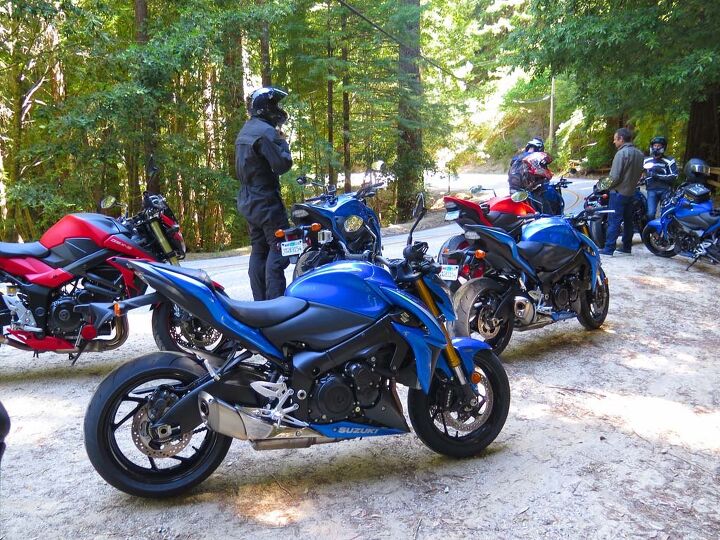 The road to Aliceís Restaurant is paved with good inventions. The red bike at left is Yoshimuraís GSX-S750 rolling test bed, and the red one up front is its GSX-S1000. The stocker gets the same Metallic Triton Blue as the MotoGP bikes, the nicest paint Iíve ever seen on a Suzuki I think. The road to Aliceís Restaurant is paved with good inventions. The red bike at left is Yoshimuraís GSX-S750 rolling test bed, and the red one up front is its GSX-S1000. The stocker gets the same Metallic Triton Blue as the MotoGP bikes, the nicest paint Iíve ever seen on a Suzuki I think.Not that they didnít give the GSX-S1000 a killer motor anyway, but the long-stroke 2005-2008 GSX-R engine in this bike has been defanged via milder camshafts and other tuning changes. Instead of screaming on to 185 (crank) horsepower at 11,500 rpm like the old K5 GSX-R, Suzuki says this one makes 145 horses at 10,000 rpm and 78.2 lb-ft of torque at 9500. Itís definitely fast enough for street use and definitely stout enough for hoiking wheelies out of every corner if youíre a good hoiker, but it doesnít have the kind of top-end rush that makes your pupils dilate. It does have that sort of rare, if not-quite-raw, flavor and raspy snarl weíd almost forgotten about after spending so much time on all the modern fly-by-wire laser-beam sportbikes. What are those long things coming out of the right grip? Throttle cables(!), and they go straight to the four butterfly valves in the GSX-Sís 44mm throttle bodies. This bike still uses Suzukiís old SDTV system (Suzuki Dual Throttle Valve) to sedate power delivery a bit, which first appeared on the amazing new GSX-R750 of 1996. 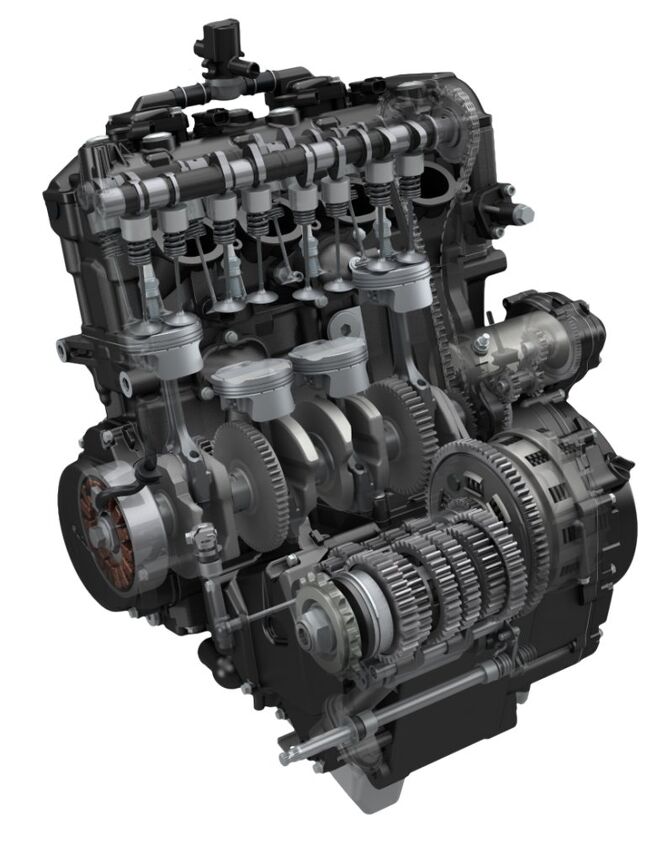 You donít get the old GSX-R1000 slipper clutch or its titanium valves. You do get 3%-lighter pistons and that classic angry/friendly snarl in a package crankshaft-rated at 145 horsepower, which will likely translate to near 130 horses at the wheel. Youíll be expected to adjust the 30mm intake and 24mm exhaust valves every 14,500 miles. Alternator output is 385 watts, and heated grips and things are in the accessories catalog. You donít get the old GSX-R1000 slipper clutch or its titanium valves. You do get 3%-lighter pistons and that classic angry/friendly snarl in a package crankshaft-rated at 145 horsepower, which will likely translate to near 130 horses at the wheel. Youíll be expected to adjust the 30mm intake and 24mm exhaust valves every 14,500 miles. Alternator output is 385 watts, and heated grips and things are in the accessories catalog.Youíre supposed to be able to sort through the three power modes on the fly with the toggle switch on the left side of the Renthal Fatbar, but I had to pull over to make my bike switch. Mode 1 gives full juice, immediate throttle response and the least traction control. Mode 2 gives full juice with slightly tamer throttle response (which I liked best) and a bit more TC. And Mode 3 is rain mode: If itís anything like whatís on the new V-Strom 1000 (it is), you should be able to climb medium-steep rocky trails without spinning the back tire out from under yourself. Which is sometimes convenient. You can also switch the system off. The Bosch ABS, though, stays on at all times. The bikeís frame is all-new, and a place where Suzuki says the 1000 lost 10 pounds compared to the 750. Using the latest computerized practical analysis technology let them build a main frame lighter than the GSX-R1000 frame; the arched swingarm is the same specification and size as the GSX-R1000 swingarm. 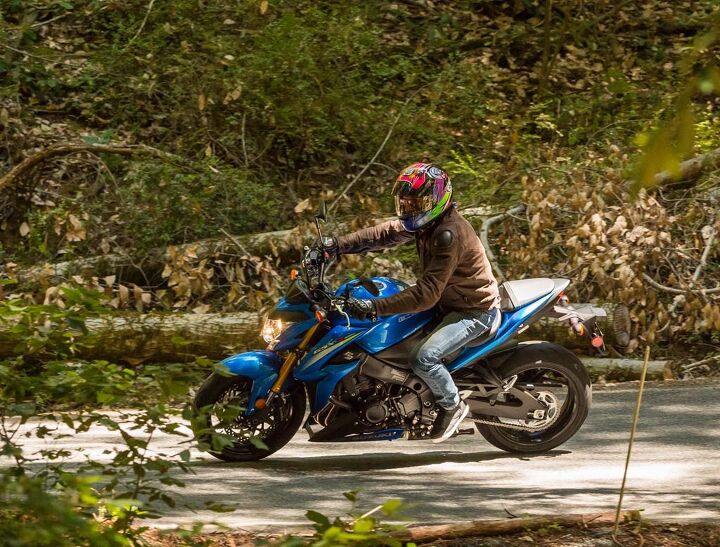 Light weight and great ergos make light work of tight backroads. Light weight and great ergos make light work of tight backroads.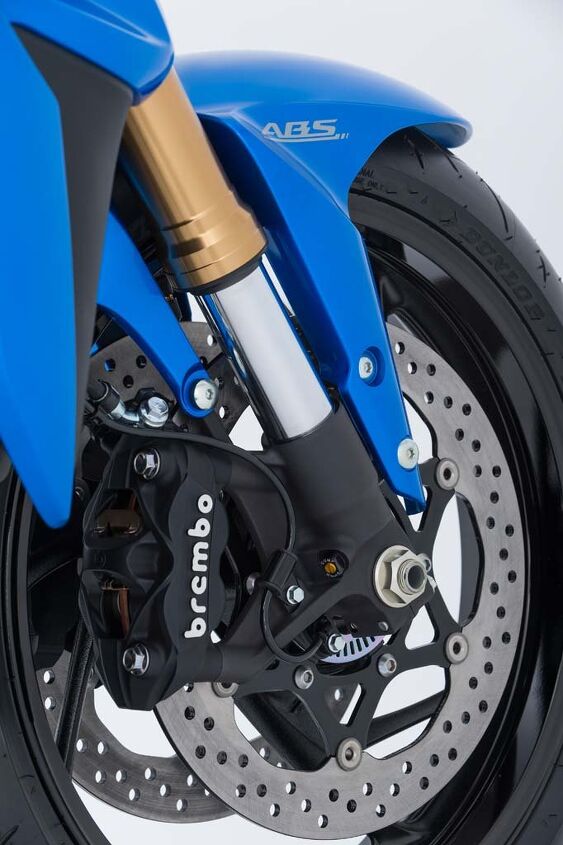 The 310mm front discs and Brembo calipers (straight off the GSX-R1000) provide massive-enough stopping power without being at all grabby when you first grab them. Suzuki says ABS only adds 1.4 lbs to the bike, and $500 to the bottom line. The 310mm front discs and Brembo calipers (straight off the GSX-R1000) provide massive-enough stopping power without being at all grabby when you first grab them. Suzuki says ABS only adds 1.4 lbs to the bike, and $500 to the bottom line.From the saddle, the new bike really does feel nice and light and controllable: The seatís reasonably low at 31.9 inches, you sit up, hominid-like behind that nice handlebar on a thick-enough seat. Steering is light enough without being too light; 3.9 inches of trail via 25.0 degrees rake, and a 57.5-in. wheelbase, is right in there with the class contenders. Besides light weight, the other part thatís expensive on motorcycles is quality suspension. KYB supposedly built all-new stuff for the GSX-S: a 43mm inverted fork with a ďdurable plated finishĒ which looks like chrome, and tapered outer tubes for optimal rigidity/compliance, anodized a light gold for that expensive look. The fork is three-way adjustable, with 4.7 inches travel. The single KYB shock out back works through its linkage to turn its 63mm stroke into 5.1 inches of wheel travel; itís rebound adjustable, and has five preload settings and a wrench under the seat, but has no adjustments for compression damping.  The backlighting is adjustable along with other things. Ride mode is usually displayed where the temp gauge is in this pic. My bike usually claimed it was getting around 44 mpg. The backlighting is adjustable along with other things. Ride mode is usually displayed where the temp gauge is in this pic. My bike usually claimed it was getting around 44 mpg.On smooth pavement, I totally concur with our man Jeff Ware, who already rode the bike in Europe, no complaints. Both ends hold up their end either hard on the gas or hard on the brakes. On choppy, bumpy, gnarly pavement, though, the GSX-Sís suspenders are no match for the stuff BMW and KTM put on the S1000R and Super Duke R. On those bikes, there almost isnít any such thing as bad pavement. On the Suzuki, youíre a pavement inspector general. The fork jabs your upper body over bumps, then the harsher rear delivers the body blow, and serial big bumps can have things feeling out of sorts. Another cost-reducing measure would be the absence of a steering damper on the GSX-S Ė a thing the BMW and KTM both use to good effect when making haste down gnarly backroads. If youíre young and tough, that sort of drama just makes you stronger. It just makes me slow down a little. I probably couldíve made things a little more compliant if thereíd been time to play with the adjusters a little. 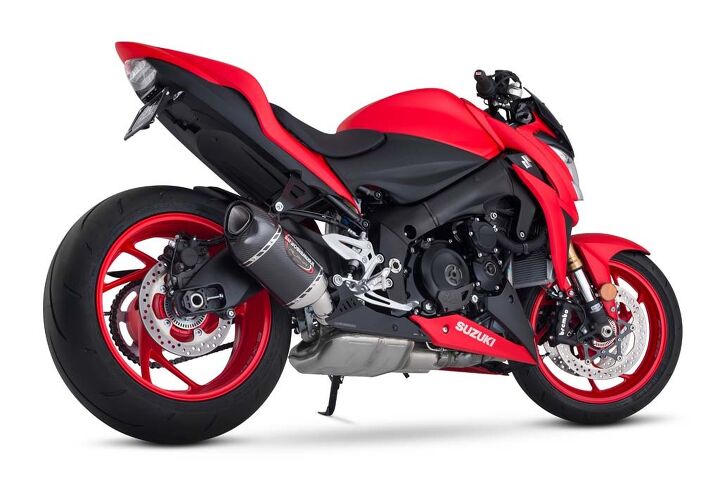 Since the bikeís only $9,999, why not order up the ÷hlins fork cartridge kit and rear shock like Yoshimura did with its GSX-S, which they brought along for the ride? Yosh has a bunch of trick items for the bike already, including a fender eliminator and its 50-state legal Signature series slip-ons ($649 for this carbon one), which require zero modifications. The rest of the under-engine exhaust is all Suzuki stainless steel, complete with catalyst and SET valve. (Custom paint by Matt Polosky at ColorZone Designs.) Since the bikeís only $9,999, why not order up the ÷hlins fork cartridge kit and rear shock like Yoshimura did with its GSX-S, which they brought along for the ride? Yosh has a bunch of trick items for the bike already, including a fender eliminator and its 50-state legal Signature series slip-ons ($649 for this carbon one), which require zero modifications. The rest of the under-engine exhaust is all Suzuki stainless steel, complete with catalyst and SET valve. (Custom paint by Matt Polosky at ColorZone Designs.)For normal riding around on reasonably smooth pavement, the GSX-S is tough to beat; the ergos are totally humane, and though youíre turning about 5500 rpm at 80 mph, the Fatbar and engine counter-balancer smother nearly all the big Fourís vibrations. For warm-weather riding, nothing beats a naked bike. For cool-weather riding and for people who just like plastic, how nice of Suzuki to also offer up the GSX-S1000F. 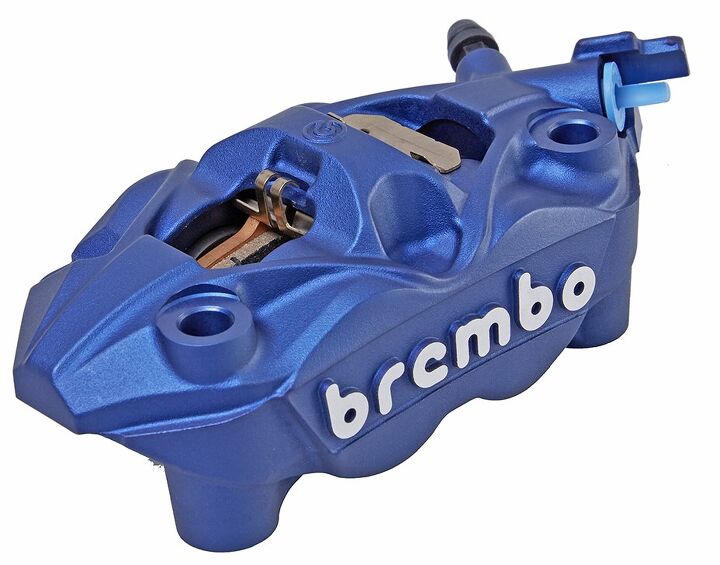 Speaking of accessories, how about some cool blue anodized brake calipers from the Suzuki catalog, which will go for about $400 each. Speaking of accessories, how about some cool blue anodized brake calipers from the Suzuki catalog, which will go for about $400 each.GSX-S1000F 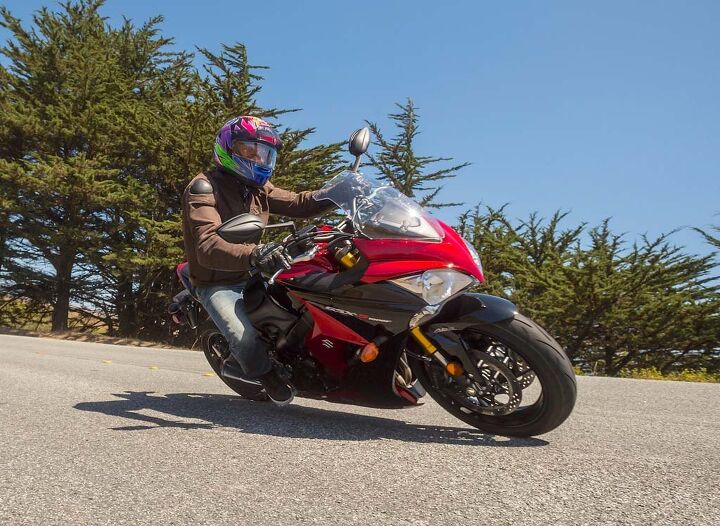 Suzuki tells us the F version is exactly the same as the S but for its H7 twin-halogen headlight-equipped fairing, a bit more oil in each fork leg and about 10 pounds more mass. The Fís only available with ABS: $10,999. (The S gets a single H4 halogen light.) Suzuki tells us the F version is exactly the same as the S but for its H7 twin-halogen headlight-equipped fairing, a bit more oil in each fork leg and about 10 pounds more mass. The Fís only available with ABS: $10,999. (The S gets a single H4 halogen light.)Suzukiís Tim Olson says American Suzuki insisted upon a faired version of the bike, and Suzuki responded with the GSX-S1000F, which it classifies as more ďsports tourerĒ versus the Sís ďsports roadster.Ē Luggage capacity, however, will be limited since no hard bags are in the works. Running along the fogged-in Pacific with the temperature in the 60s in my lovely new perforated Dainese jacket, I was just about as chilly on the F as I had been on the S, but I suppose the fairing would help if it really was cold and you were dressed for it, and added heated grips and the taller accessory windscreen Ė maybe some handguards. Aesthetically, from the front, I canít help thinking Angry Birds. When we start delving into the sports-tourer arena, this creature is going to require more comforts than a small fairing and an extra headlight… 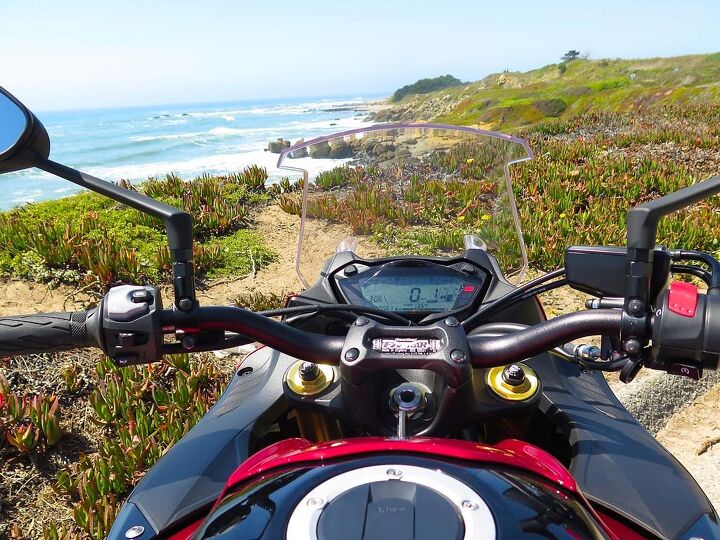 The F version pokes a slightly bigger hole in the atmosphere. One cool new feature is Suzukiís new Easy Start: Just jab the button and the 32-bit ECU spins the starter exactly the right amount to achieve ignition Ė never more than 1.5 seconds! Quite a change from my old GS550, which would crank until dead. A new ďOpen typeĒ regulator/rectifier opens the stator output to control the charging level to the battery, using smaller components that produce less heat. The F version pokes a slightly bigger hole in the atmosphere. One cool new feature is Suzukiís new Easy Start: Just jab the button and the 32-bit ECU spins the starter exactly the right amount to achieve ignition Ė never more than 1.5 seconds! Quite a change from my old GS550, which would crank until dead. A new ďOpen typeĒ regulator/rectifier opens the stator output to control the charging level to the battery, using smaller components that produce less heat.Anyway, there you have it. For $9,999 Ė way less expensive than the bikes Suzukiís gunning for here, including the Triumph Speed Triple and Yamaha FZ1, the rare but very nice Honda CB1000R, the Z1000 Kawasaki Ė I give the S two thumbs way up. In its MotoGP-inspired paint, itís one of the prettiest nakeds out there. Itís light and powerful, makes the right noises, runs super-smooth down the superslab, itís cucumber-cool and comfortable. Will it rekindle the GSX-R flame in the hearts of the middle-aged American malefactors who embraced the original lightweight wonder 30 years ago? Fingers crossed. I hope so. + Highs</p>
 2016 Suzuki GSX-S1000 ABSEngine TypeLiquid-cooled, four-stroke, forward-inclined inline four-cylinder, four-valve per cylinder, DOHCEngine Capacity999 ccBore x Stroke73.4 mm x 59 mmHorsepower145 hp at 10000 rpm (claimed)Torque78.2 lb-ft. at 9500 rpm (claimed)Compression12.2 : 1Fuel System44mm throttle-bodies w SDTV and 3-mode TC, 10-hole long-nose fuel injectorsClutchWet, multi-plateTransmission6-speed constant-meshFinal DriveChainFront Suspension43mm KYB fully adjustable telescopic fork, 4.7-in. travelRear SuspensionKYB link type single shock with rebound and preload adjustment, 5.1-in. travelFront BrakesDual 310mm semi-floating disc, Brembo radial-mount 32mm four-piston caliperRear BrakesSingle 220 mm disc, one-piston Nissin caliperFront TireDunlop D214 120/70-17Rear TireDunlop D214 190/50-17Seat Height31.9 in.Rake/Trail25į/3.9 in.Wheelbase57.5 in.Ground clearance5.5ĒCurb Weight (Claimed)461 lb. / 459 lb. base model/ 471 lb. GSX-S1000FFuel Capacity4.5 gal.ColorsMetallic Triton BlueMSRP$10,499 ($9,999 base), $10,999 GSX-S1000F 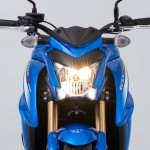 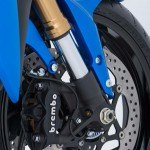 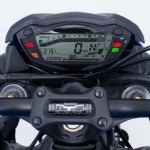 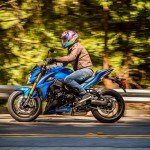 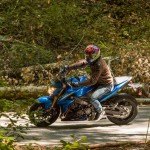  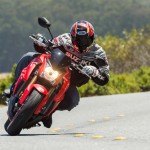 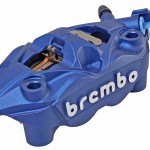 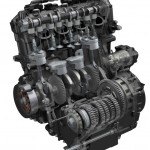 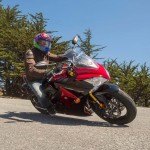 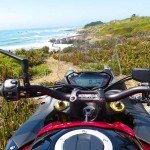 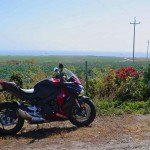  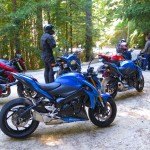 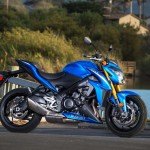 2016 Suzuki GSX-S1000 / GSX-S1000F First Ride Review appeared first on Motorcycle.com. 2016 Suzuki GSX-S1000 / GSX-S1000F First Ride Review appeared first on Motorcycle.com.Click here for full story...
__________________________________________________
I'm a bot. I don't need no stinkin' signature... |
|
|

|
 |
 Similar Threads
Similar Threads
|
||||
| Thread | Thread Starter | Forum | Replies | Last Post |
| [motorcyclistonline] - 2016 Suzuki GSX-S1000 and GSX-S1000F | FIRST RIDE | Ninjette Newsbot | Motorcycling News | 0 | July 29th, 2015 07:50 PM |
| [motorcycle.com] - 2016 Suzuki GSX-S1000 First Ride Review | Ninjette Newsbot | Motorcycling News | 0 | April 1st, 2015 03:50 PM |
| [RoadRUNNER] - 2016 Suzuki GSX-S1000 and GSX-S1000F ABS | Ninjette Newsbot | Motorcycling News | 0 | October 20th, 2014 03:01 AM |
| [cyclenews.com] - First Look: 2016 Suzuki GSX-S1000/2015 GSX-S750 Naked Bikes | Ninjette Newsbot | Motorcycling News | 0 | October 3rd, 2014 03:00 AM |
| [motorcycle.com] - 2016 Suzuki GSX-S1000, GSX-S1000F, and GSX-S1000F ABS Preview | Ninjette Newsbot | Motorcycling News | 0 | October 2nd, 2014 11:40 AM |
|
|